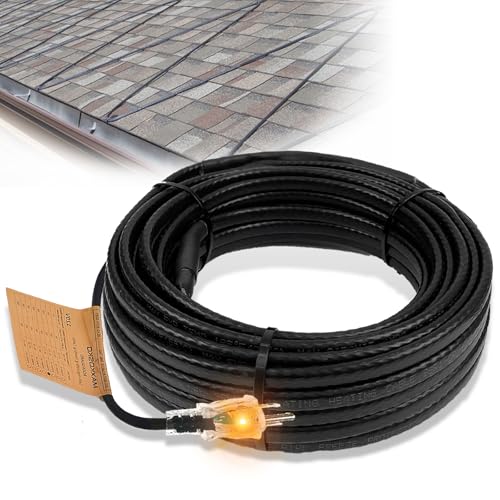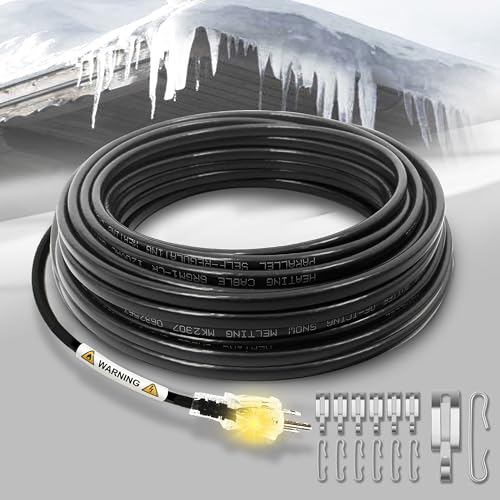Winter roof ice and clogged gutters can cause costly damage. This guide compares five top electric gutter heater cables suited for melting snow, preventing ice dams, and protecting downspouts. Below is a quick comparison, followed by focused product overviews and a practical buying guide to help select the right cable for your roof, gutter type, and local climate.
| Product | Length / Wattage | Key Feature | Best For |
|---|---|---|---|
| MAXKOSKO Roof Gutter Heat Cable (80 Ft) | 80 ft / 6 W/ft | Self-regulating, heavy-duty fluoropolymer jacket | Large roofs & continuous gutter runs |
| Wrap-On Roof And Gutter Deicing Cable (250 Ft) | 250 ft / 5 W/ft | Complete kit with clips & spacers | Long runs, pitched roofs, full-house coverage |
| MAXKOSKO Gutter Heater (36 Ft) | 36 ft / 8 W/ft | Self-regulating, designed for NA markets | Targeted roof edges, gutters and downspouts |
| YeloDeer 36 Ft Industrial Grade Cable | 36 ft / 8 W/ft | High output for fast melting, tinned copper core | Heavier snowfall regions or steep sections |
| SnulyHeet 50 Ft Heat Trace | 50 ft / 7 W/ft | Durable PE sheath, wide temperature tolerance | Mid-length runs requiring robust temperature range |
Content Navigation
- MAXKOSKO Roof Gutter Heat Cable 80 Ft
- Wrap-On Roof And Gutter Deicing Cable 250 Ft
- MAXKOSKO Gutter Heater 36 Ft Self-Regulating Cable
- YeloDeer 36 Ft Industrial Grade Gutter Heater Cable
- SnulyHeet 50 Ft Heat Trace For Gutters And Pipes
- Buying Guide: How To Choose An Electric Gutter Heater
- 1. Self-Regulating Vs. Constant Wattage
- 2. Wattage Per Foot And Melt Performance
- 3. Cable Length And Run Planning
- 4. Material Durability And Weather Resistance
- 5. Mounting Accessories And Installation Kits
- 6. Electrical Requirements And Lead Length
- 7. Temperature Ratings And Safety Limits
- 8. Intended Application: Gutters, Downspouts, Pipes, Or Roofs
- 9. Installation Complexity And Overlap Rules
- 10. Warranty, Certifications, And Code Compliance
- Comparison Perspectives To Consider
MAXKOSKO Roof Gutter Heat Cable 80 Ft

This 80-foot MAXKOSKO cable is a self-regulating roof de-icing solution designed to prevent icicles, ice dams, and snow buildup along roof edges and gutters. The cable adjusts output with ambient temperature, which helps conserve energy and lowers overheating risks.
Construction highlights include a pure copper inner core, PVC inner sleeve, copper winding explosion-proof layer, and a fluoropolymer outer jacket rated for high and low temperatures. These materials support long-term outdoor exposure where UV, moisture, and friction are common.
Use cases: continuous gutter runs, long eaves, and sections where uniform heat distribution is desired. As a self-regulating cable, it reduces the need for separate thermostats or frequent monitoring; accessories for mounting may be required separately depending on installation layout.
Wrap-On Roof And Gutter Deicing Cable 250 Ft

Call 888-896-7031 for Free Local HVAC Quotes – Compare and Save Today!
The Wrap-On deicing cord provides a long 250-foot length operating at 120V and 5 W/ft. It’s supplied as a ready-to-install package with shingle clips, cable spacers, and installation instructions, which simplifies full-house coverage or long roof perimeter runs.
Designed for pitched roofs with non-combustible tab shingles, the cable is intended for use in gutters and downspouts. Because it is constant wattage at 5 W/ft, consider layout and spacing carefully to avoid overheating when overlapping or close proximity to combustible materials.
Use cases: whole-roof perimeter protection, lengthy gutter systems, and installations where a complete kit with mounting hardware is preferred. Confirm compatibility with roof materials before installation and follow included instructions for clips and spacers.
MAXKOSKO Gutter Heater 36 Ft Self-Regulating Cable

This 36-foot MAXKOSKO cable offers an 8 W/ft rating and is described as tailored for roofing and gutter use in North America. The self-regulating design limits overheating risks by reducing output as ambient temperature rises.
Key characteristics: heavy-duty cable structure, compatibility notes for accessories (some may be sold separately), and a focus on safety and energy efficiency. The cable’s design aims to deliver reliable operation across seasonal temperature swings without burning out.
Call 888-896-7031 for Free Local HVAC Quotes – Compare and Save Today!
Use cases: smaller roof sections, targeted downspouts, or localized gutter runs where higher wattage is desired for quicker melt rates. For installations requiring accessory clips or spacers, source compatible mounting hardware as needed.
YeloDeer 36 Ft Industrial Grade Gutter Heater Cable

The YeloDeer 36-foot cable supplies 8 W/ft using self-regulating technology designed to adapt heat output to colder temperatures. The product emphasizes a tinned copper core, polyolefin inner insulation, and a protective PE layer to prioritize safety and durability.
Stronger wattage per foot supports faster snow and ice melting, suitable for steeper eaves, exposed sections, or areas with heavier snowfall. The 6-foot cold lead with an indicator light facilitates power connection while providing a clear status signal.
Use cases: sections needing aggressive melt performance, such as roof valleys, gutter ends prone to clogging, or short runs where rapid thawing is required. Confirm mounting hardware and routing plan before installation.
SnulyHeet 50 Ft Heat Trace For Gutters And Pipes

SnulyHeet offers a 50-foot heat trace rated at 7 W/ft with a focus on temperature tolerance and durable construction. The cable claims an operational tolerance down to -40 °F and to temperatures up to 150 °F at the cable surface.
Materials include polyethylene sheathing for inner insulation and outer layers, aiming to withstand freeze-thaw cycles and exposure. The product targets both gutter and pipe protection, providing flexibility for combined applications in a property.
Use cases: mid-length roof runs, combined pipe and gutter protection needs, and installations in climates with extreme cold where a robust temperature tolerance is desirable. Confirm routing to avoid unwanted overlap and ensure proper spacing for efficient melt patterns.
Buying Guide: How To Choose An Electric Gutter Heater
Selecting the right gutter heater involves understanding roof geometry, local climate, power availability, and installation considerations. Below are the primary factors to evaluate before purchase.
1. Self-Regulating Vs. Constant Wattage
- Self-Regulating Adjusts heat output based on ambient temperature. More energy-efficient and reduces risk of overheating when overlapped.
- Constant Wattage Delivers steady heat per foot. Simpler in design but requires careful layout to avoid hot spots and potential overheating if overlapped.
2. Wattage Per Foot And Melt Performance
Typical ratings range from about 5 W/ft to 8 W/ft. Higher W/ft
3. Cable Length And Run Planning
Measure gutter and downspout lengths and plan runs along problematic areas like eaves, valleys, and downspouts. Longer continuous cables minimize splice points but consider whether you need multiple shorter runs for targeted zones.
4. Material Durability And Weather Resistance
Look for robust outer jackets such as fluoropolymer, PE, TPE, or weather-rated polyolefin. These materials improve UV resistance, moisture protection, and abrasion resistance for rooftop exposure.
5. Mounting Accessories And Installation Kits
Kits that include shingle clips, spacers, and installation instructions reduce complexity. If a cable does not include clips, plan to buy roof-safe mounting hardware and follow manufacturer spacing guidelines to avoid roof damage.
6. Electrical Requirements And Lead Length
Most cables run on 120V and include a cold lead with a plug or connector. Confirm power access near the installation area and ensure the cold lead length suits routing without requiring extension that violates safety guidance. For hardwired installations, consult local code and a licensed electrician.
7. Temperature Ratings And Safety Limits
Review the cold and maximum surface ratings to confirm the cable will operate safely in expected conditions. Cables rated to operate effectively at very low ambient temperatures (e.g., -40 °F) provide more assurance in extreme climates.
8. Intended Application: Gutters, Downspouts, Pipes, Or Roofs
Some cables are optimized for gutters and downspouts; others work for exposed pipes or flat metal roofs. Match the product to your intended use. For combined needs, choose a cable rated for both gutters and pipes or run separate cables optimized per application.
9. Installation Complexity And Overlap Rules
Self-regulating cables are generally safer if some overlap occurs, but check manufacturer guidance. Constant wattage products require strict attention to avoid overlapping or crossing that may create hotspots.
10. Warranty, Certifications, And Code Compliance
Confirm manufacturer warranty terms and whether the cable meets relevant electrical and safety standards. Local building codes may require specific installation practices, permits, or licensed electricians for hardwired systems.
Tips for Getting the Best HVAC Prices
- Prioritize Quality Over Cost
The most critical factor in any HVAC project is the quality of the installation. Don’t compromise on contractor expertise just to save money. - Check for Rebates
Always research current rebates and incentives — they can significantly reduce your overall cost. - Compare Multiple Quotes
Request at least three estimates before making your choice. You can click here to get three free quotes from local professionals. These quotes include available rebates and tax credits and automatically exclude unqualified contractors. - Negotiate Smartly
Once you've chosen a contractor, use the proven strategies from our guide — How Homeowners Can Negotiate with HVAC Dealers — to get the best possible final price.
Comparison Perspectives To Consider
- Coverage Vs. Power: Longer, lower-wattage cables (e.g., 5 W/ft) suit perimeter coverage, while shorter high-wattage cables (7–8 W/ft) target problem spots.
- Durability Vs. Cost: Heavier protective jackets add longevity but can raise cost. Factor expected exposure and wind/ice abrasion risk.
- Ease Of Installation: Kits with clips and spacers reduce installation time. If you plan a professional install, supply-only cables may suffice.
- Energy Efficiency: Self-regulating cables lower power draw when temperatures moderate, which can reduce winter energy consumption.
- Flexibility: Choose cables compatible with both gutters and downspouts if you need multi-purpose protection.
